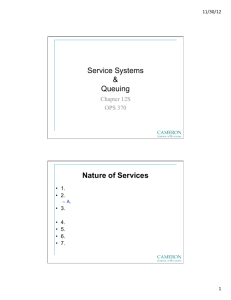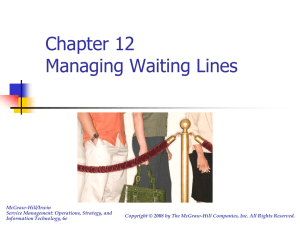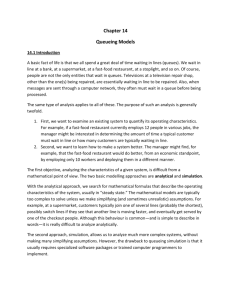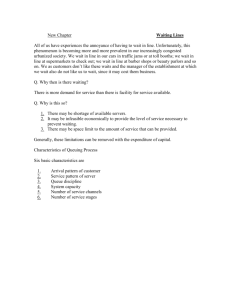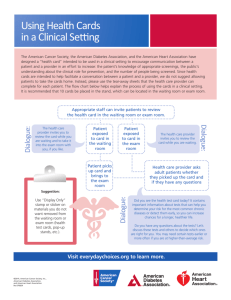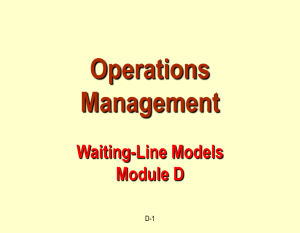Service Quality
advertisement
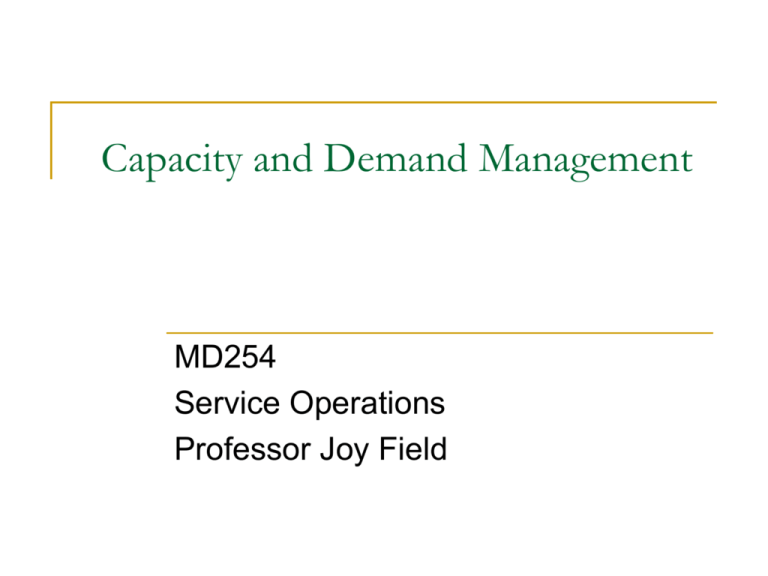
Capacity and Demand Management MD254 Service Operations Professor Joy Field Strategic Role of Capacity Decisions in Services A capacity expansion strategy can be used proactively to: Create demand through supply (e.g. JetBlue, Dunkin Donuts) Lock out competitors, especially where the market is too small for two competitors (e.g. WalMart) Get down the learning curve to reduce costs (e.g. Southwest Airlines) Support fast delivery and flexibility (e.g. Mandarin Oriental) A lack of short-term capacity can generate customers for the competition (e.g. restaurant staffing) Capacity decisions balance costs of lost sales if capacity is inadequate against operating losses if demand does not reach expectations. Strategy of building ahead of demand is often taken to avoid losing customers. Capacity Planning Challenges in Services Inability to create a steady flow of demand to fully utilize capacity Enforced idle capacity if no customers are in the service system Customers are participants in the service and the level of congestion impacts perceived quality. Customer arrivals fluctuate and service demands also vary. Capacity is typically measured in terms of (bottleneck) resources rather than outputs (e.g. number of airplane seats available per day rather than number of passengers flown per day). Customer-Induced Demand and Service Time Variability Arrival: customer arrivals are independent decisions not evenly spaced. Capability: the level of customer knowledge and skills and their service needs vary Request: uneven service times result from unique demands. Effort: level of commitment to coproduction or selfservice varies. Subjective Preference: personal preferences introduce unpredictability. Modeling Service Delivery Systems Using Queuing Models Customer population The service system The source of input to the service system Whether the input source is finite or infinite Whether the customers are patient or impatient Number of lines - single vs. multiple lines Arrangement of service facilities – servers, channels, and phases Arrival and service patterns – e.g. for many service processes, interarrival and service times are exponentially distributed (arrival and service rates are Poisson distributed) Priority rule (queue discipline) Static First-come, first-served (FCFS) discipline Dynamic Individual customer characteristics: e.g. earliest due date (EDD), shortest processing time (SPT), priority, preemptive Status of the queue, e.g. number of customers waiting, round robin Queue Configurations and Service Performance Multiple Queue Single queue Take a Number 3 4 8 2 6 10 12 11 5 7 9 Enter Arrangement of Service Facilities Channels and Phases Service facility Server arrangement Parking lot Self-serve Cafeteria Servers in series Toll booths Servers in parallel Supermarket Self-serve, first stage; parallel servers, second stage Hospital Many service centers in parallel and series, not all used by each patient Distribution of Patient Interarrival Times for a Health Clinic Relative frequency, % Patient interarrival times approximate an exponential distribution. 40 30 20 10 0 1 3 5 7 9 11 13 15 17 19 Patient interarrival time, minutes 3.5 3 2.5 2 1.5 1 0.5 0 1 3 5 7 9 11 13 15 17 19 21 23 Percentage of average daily physician visits Average calls per hour Temporal Variation in Arrival Rates 140 130 120 110 100 90 80 70 60 1 2 3 4 Hour of day Day of w eek Ambulance Calls by Hour of Day Physician Arrivals by Day of Week 5 Queue Discipline Queue discipline Static (FCFS rule) Dynamic Selection based on individual customer attributes Selection based on status of queue Number of customers waiting Round robin Priority Preemptive Processing time of customers (SPT or cµ rule) Single-Server, Exponential Interarrival and Service Times (M/M/1) Model Assumptions: Number of servers = 1 Number of phases = 1 Input source: infinite, no balking or reneging Arrivals: mean arrival rate = ; mean interarrival time = 1 / Service: mean service rate = ; mean service time = 1 / Waiting line: single line; unlimited length Priority discipline: FCFS Single-Server Operating Characteristics Average utilization: Probability that n customers are in the system: Pn (1 )n Probability of less than n customers in the system: Pn 1 n Average number of customers in the system: Ls Average number of customers in line: Lq Ls Average time spent in the system: Ws Average time spent in line: Wq Ws 1 Multiple-Server (M/M/c) Model Assumptions: Number of servers = M Number of phases = 1 Input source: infinite, no balking or reneging Arrivals: mean arrival rate = ; mean interarrival time = 1 / Service: mean service rate = ; mean service time = 1 / Waiting line: single line; unlimited length Priority discipline: FCFS Multiple-Server Operating Characteristics Average utilization: M M 1 ( / ) n Probability that zero customers are in the system: P0 [ n 0 Probability that n customers are in the system: ( / ) n ( / ) n P0 for 0 n M, P for n M n M 0 n! M!M P0 ( / ) M Average number of customers in line: Lq M!(1 ) 2 L 1 Average time spent in line/system: Wq q , Ws Wq n! Average number of customers in the system: Ls Ws Average waiting time for an arrival not immediately served: Wa Prob. that an arrival will have to wait for service: Pw Wq Wa ( / ) M 1 ] M!(1 ) 1 M Capacity Utilization and Capacity Squeeze A capacity squeeze is the breakdown in the ability of the operating system to serve customers in a timely manner as the capacity utilization approaches 100%. As the variability in arrival and service rates increases, a capacity squeeze occurs at a lower capacity utilization. 100 System line length With: Then: Ls 1 10 8 0 0.2 0.5 0.8 0.9 0.99 6 4 2 0 0 Capacity utilization 1.0 Ls 0 0.25 1 4 9 99 Service System Cost Tradeoff Total Cost of Service Let: Cw = Hourly cost of waiting customer Cs = Hourly cost per server C = Number of servers Total cost/hour = Hourly service cost + Hourly customer waiting cost Total cost/hour = Cs C + Cw Ls The total cost of service reflects both the firm’s capacity cost as well as the customers’ cost of waiting. Service processes should be designed to minimize the sum of these two costs. How can the economic cost of customer waiting be determined? Queuing Model Takeaways Variability in arrivals and service times contribute equally to congestion as measured by Lq. Even though servers will be idle some of the time, there will be customer lines and waits, on average. These lines/waits will get very long very quickly as capacity utilization approaches 100%. Given the potential for a capacity squeeze as capacity utilization approaches 100%, service firms typically design their processes with a capacity cushion (i.e., the amount of capacity above the average expected demand). The greater the variability in arrival/service rates, the larger the capacity cushion needed for a given service level. To improve system performance (waits and line lengths): A single queue vs. multiple queues with multiple channels. More servers can be added (reducing capacity utilization but at a higher operating cost). A fast single server is preferred to multiple-servers with the same overall service rate. Managing Waiting Lines In a lifetime, the average person will spend: SIX MONTHS Waiting at stoplights EIGHT MONTHS Opening junk mail ONE YEAR Looking for misplaced objects TWO YEARS Reading E-mail FOUR YEARS Doing housework FIVE YEARS Waiting in line SIX YEARS Eating The Psychology of Waiting People dislike “empty” time – Fill this time in a positive way. Service-related diversions convey a sense that the service has started (e.g. handing out menus). Waiting can induce anxiety in some customers – Reduce anxiety by providing information to the customer (e.g. expected wait times). Customers want to be treated “fairly” while waiting – First-come-first-served (FCFS) queuing discipline or logical prioritization process (e.g. triage) Managing the Customer Waiting Experience Conceal the queue from the customer. Engage the customer in co-production tasks during the wait. Provide diversions during the wait. Serve priority customers or customers who are willing to plan ahead faster. Automate standard services to enable self-service. Manage waiting time perceptions – under promise, over deliver. Managing Demand and Capacity to Reduce Lines and Waiting Times MANAGING DEMAND Developing complementary services Reservation systems and overbooking MANAGING CAPACITY Segmenting demand Sharing capacity Offering price incentives Crosstraining employees Promoting off-peak demand Using part-time employees Yield management Increasing customer participation Scheduling work shifts Creating adjustable capacity Managing Demand Segmenting demand (e.g. random vs. scheduled arrivals) Offering price incentives (e.g. lower matinee pricing at movie theaters) Promoting off-peak demand (e.g. use of a resort hotel during the off-season for business or professional groups) Developing complementary services (e.g. HVAC) Reservation systems and overbooking (tradeoff between opportunity cost of unused capacity and costs of not honoring an overbooked reservation) Managing Capacity Increasing customer participation (e.g. e-commerce) Scheduling work shifts (based on historical demand patterns and desired service level) Creating adjustable capacity (e.g. Tesco online grocery fulfillment) Using part-time employees (e.g. during tax season) Cross-training employees (to increase workforce flexibility and leverage capacity to provide additional value-added services) Sharing capacity (e.g. gate-sharing arrangements) Flow Management Three stage service process, average service rates: Customers 40/hour 20/hour 40/hour Customers (highly variable arrival rate, average=20/hour) Flow management focuses on relieving bottlenecks so that customers can move more smoothly and quickly through the service process. How can the flow of this service process be improved? Resource-side Demand-side Maximizing Utilization vs. Flow Management Customers 40/hour 20/hour 40/hour Customers Compare and contrast the process performance with a maximizing utilization vs. flow management approach. Why does flow management usually improve capacity utilization, but maximizing utilization often results in poor flow? Yield Management Yield management attempts to dynamically allocate fixed capacity to match the potential demand in various market segments to maximize revenues and profits. Although airlines were the first to develop yieldmanagement, other capacity-constrained service industries (e.g. hotels, car rental firms, cruises) also use yield management. Possible ethical issues associated with yield management? (http://en.wikipedia.org/wiki/Yield_management) Ideal Characteristics for Yield Management Relatively fixed capacity Ability to segment markets (i.e., discount allocation) Perishable inventory (i.e., potential for “spoilage”) Product sold in advance Fluctuating demand Low marginal fulfillment costs and high marginal capacity change costs
